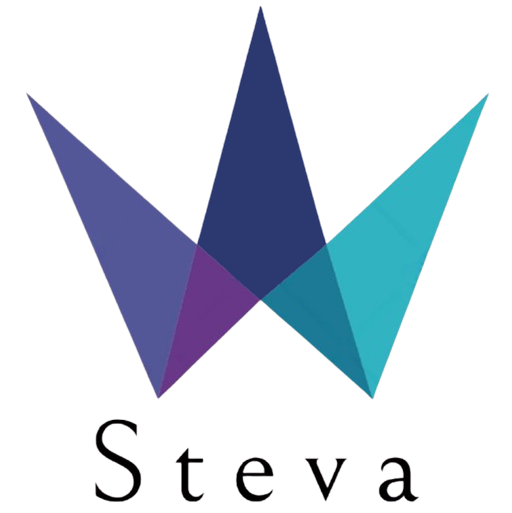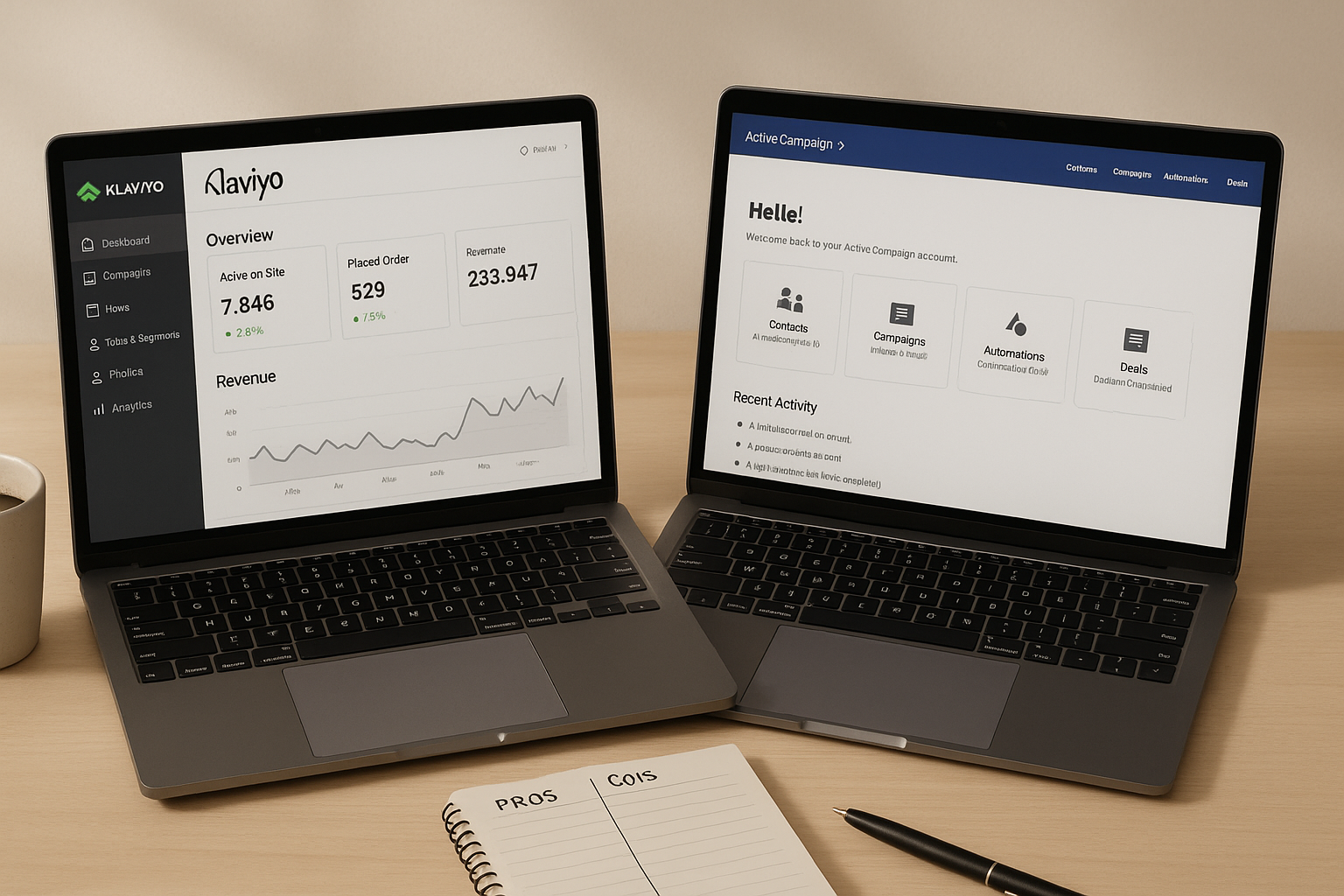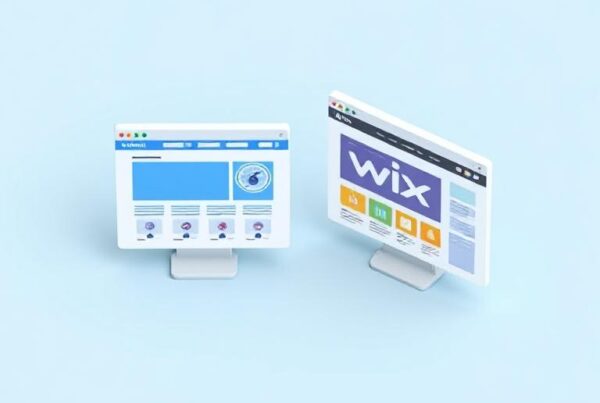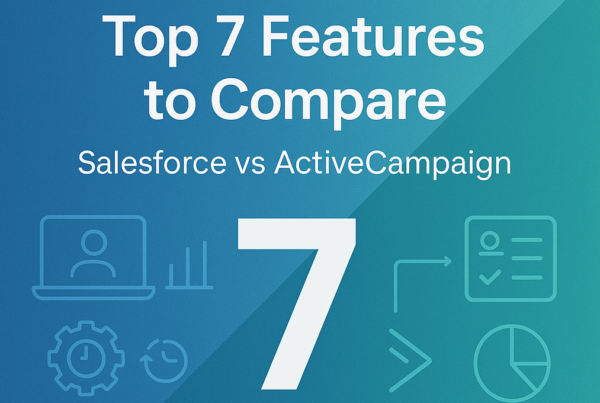When it comes to Klaviyo vs. ActiveCampaign, choosing the right email marketing platform can have a significant impact on your bottom line. Klaviyo claims its email and SMS marketing automation helped drive $14 billion in online store revenue in 2022. With eCommerce sales projected to reach almost $7.5 trillion by 2026, investing in the right marketing tools has never been more crucial.
Both platforms offer compelling features, but they serve different needs. ActiveCampaign integrates seamlessly with over 900 apps, making it a versatile choice for businesses using multiple tools. Meanwhile, Klaviyo connects with over 300 platforms and is considered the ultimate eCommerce marketing platform. Whether comparing ActiveCampaign price options or evaluating Klaviyo’s monthly cost, your decision should align with your specific business requirements. Additionally, 55% of online shoppers prefer to communicate with companies via email, underscoring the importance of choosing between these powerful platforms.
As you weigh your options, consider that ActiveCampaign offers a more comprehensive set of features and tools. At the same time, Klaviyo focuses specifically on e-commerce features such as abandoned cart recovery and personalized product recommendations. This detailed comparison will help you determine which platform can drive the most sales for your business in 2025 and beyond.
Comparison Table: Klaviyo vs Activecampaign
Compare Klaviyo vs ActiveCampaign across key features, pricing, automation, and integrations. This side-by-side table helps you quickly choose the best email marketing platform for your business needs.
| Feature | Klaviyo | ActiveCampaign |
| Integration Ecosystem | 300+ platforms | 900+ apps |
| Email Templates | ~100-160 templates | 250+ templates |
| Form Types | 4 types (embed, popup, full page, flyout) | 4 types (inline, floating box, floating bar, modal popup) |
| Automation Triggers | Single trigger per workflow | Multiple triggers per workflow |
| Segmentation Conditions | Up to 13 conditions | Up to 20 conditions |
| Starting Price (1,000 contacts) | $30/month (Email-only) | $15/month (Starter plan) |
| Free Option | Free plan up to 250 contacts | 14-day free trial |
| Interface Design | Clean, minimalist, streamlined | Feature-rich, more complex |
| Primary Focus | eCommerce-specific features | Comprehensive marketing tools |
| Analytics Emphasis | Revenue per Recipient (RPR), predictive analytics, customer lifetime value, purchase frequency, average order value | Multi-touch attribution, engagement metrics (open rates, click rates, conversion rates) |
| Predictive Analytics | Purchase likelihood, lifetime value, churn risk, next order date, spending potential, time between orders | Behavior-based triggers, pattern matching, and win probability (for sales) |
| Form A/B Testing | Supports multiple versions of testing | Limited testing capabilities (primarily email & automations) |
| Pre-built Automation | Limited but eCommerce-focused flows | Extensive automation recipes |
| Revenue Impact | $14 billion in online store revenue (2022) | Not mentioned |
Automation Workflows and Triggers
Automation capabilities often determine the effectiveness of an email marketing platform for driving sales. Both Klaviyo and ActiveCampaign offer robust automation features, yet they differ substantially in their approach and capabilities.
1. Pre-built Templates: Flows vs Automation Recipes
ActiveCampaign offers an extensive library of pre-designed templates, known as “automation recipes,” that cover virtually every marketing scenario. These recipes include templates for abandoned cart emails, welcome series, opt-in incentives, drip campaigns, targeted product follow-ups, and post-purchase sequences. This comprehensive selection enables you to quickly implement sophisticated marketing strategies without having to build workflows from scratch.
Conversely, Klaviyo offers a more streamlined selection of templates called “flows.” Though more limited in number compared to ActiveCampaign’s extensive library, Klaviyo’s flows are specifically designed for e-commerce scenarios.
Many users report that Klaviyo’s automation is more intuitive to implement despite having fewer options. For businesses primarily focused on e-commerce, Klaviyo’s specialized templates may provide sufficient functionality without overwhelming users with options.
Are you seeking a platform that strikes a balance between simplicity and power? ConvertKit offers creator-focused features that span from basic to complex solutions. Check out our [ConvertKit vs. ActiveCampaign: Which Email Marketing Tool Is Right for Your Business?] comparison to see if it might be the perfect middle-ground solution.
2. Trigger Options: Single vs Multiple Triggers
The most significant technical difference between these platforms lies in their trigger capabilities. ActiveCampaign allows you to set multiple triggers for each automation workflow, enabling contacts to enter the same automation through different pathways. For instance, a nurture sequence could be triggered by downloading a lead magnet, clicking a specific link, or joining a segment.
In contrast, Klaviyo restricts each flow to a single trigger, thereby limiting the flexibility of your automation strategy. This fundamental difference means that with Klaviyo, you’ll likely need to create separate flows for scenarios that ActiveCampaign could handle with a single automation.
If ActiveCampaign feels too complicated or time-consuming, you’re not alone. Check out [Why Businesses Are Switching From ActiveCampaign: Best Alternatives for 2025] to find powerful tools that are much easier to use.
3. Automation Map: Visualizing Customer Journeys
Effective marketing requires understanding how customers interact with your brand across different touchpoints. Both platforms offer visualization tools that help map these journeys with other approaches.
ActiveCampaign offers a comprehensive visual automation builder that enables you to create intricate, multi-step workflows incorporating emails, SMS, website messages, and even CRM updates. This visual representation helps you conceptualize how customers move through your marketing funnel.
Although Klaviyo’s visualization capabilities aren’t as extensive, they allow you to map basic customer journeys effectively. Remember that most customer journeys aren’t linear. They occur in spurts with varying time intervals between interactions. Both platforms account for this reality, though ActiveCampaign offers more sophisticated branching options.
4. Sales Funnel Automation: Post-Purchase and Abandoned Cart
For e-commerce businesses, abandoned carts and post-purchase sequences often generate substantial revenue. Both platforms excel in these areas, albeit with different strengths. Klaviyo’s abandoned cart flows automatically to check for purchase completion before sending reminders.
Their recommended approach involves sending the first message 2-4 hours after cart abandonment, followed by a second email 20-48 hours later. Klaviyo also excels at displaying dynamic content blocks that showcase the specific items left in customers’ carts.
- ActiveCampaign’s abandoned cart automation offers extensive customization options.
- You can configure triggers based on store, product, category, or cart value.
- ActiveCampaign allows you to segment contacts entering the automation based on additional criteria, providing more targeted recovery campaigns.
For post-purchase follow-ups, ActiveCampaign’s multiple trigger capability gives it an edge, allowing you to create comprehensive sequences that respond to different customer behaviors after purchase. However, Klaviyo’s e-commerce-specific focus means its post-purchase flows are streamlined for online retailers.
Segmentation and Personalization Capabilities
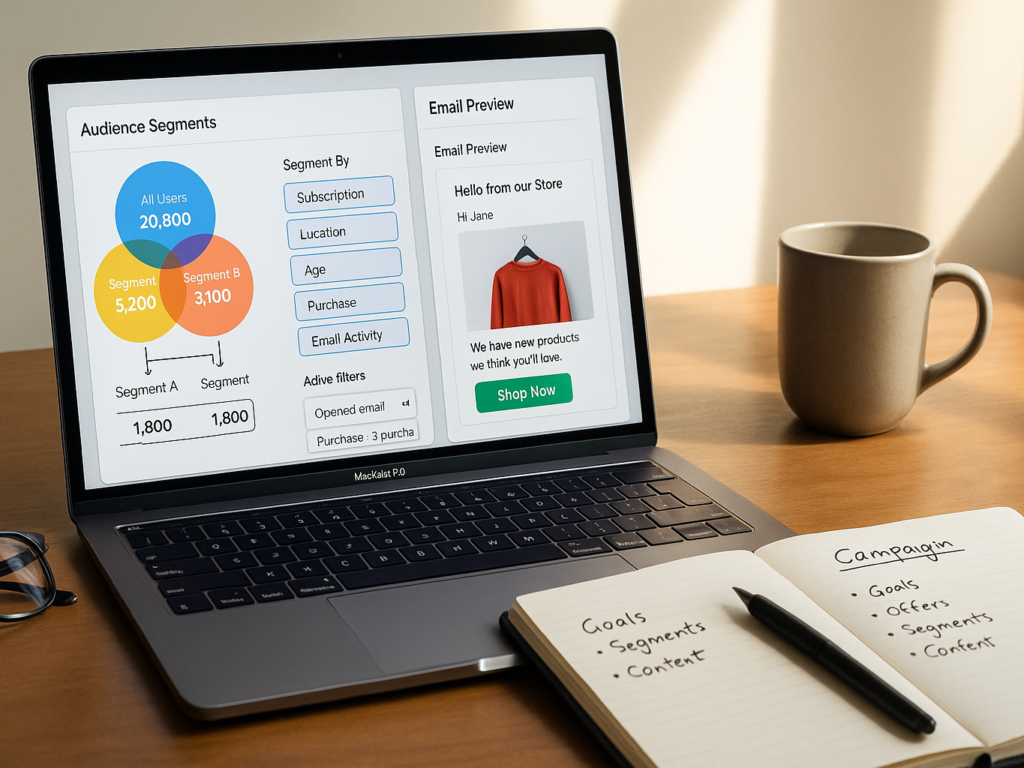
Effective segmentation differentiates between generic mass emails and highly targeted messages that drive conversions. Klaviyo vs ActiveCampaign offer powerful segmentation features, yet their approaches differ in several key areas.
1. Tag-Based vs. Behavior-Based Segmentation
Klaviyo and ActiveCampaign handle contact segmentation using different methodologies. Klaviyo provides default segments for new subscribers and those who’ve engaged with emails over the past 30-90 days, making the initial setup straightforward. However, this convenience comes with limitations.
ActiveCampaign employs a more robust tagging system that enables true 1:1 automated personalization. Unlike Klaviyo, ActiveCampaign allows you to apply tags to users already in workflows and use these tags to trigger specific automation sequences. This flexibility creates more sophisticated targeting options.
When comparing ActiveCampaign and Klaviyo, the fundamental difference lies in how they organize customer data. While both platforms support tag-based grouping, ActiveCampaign additionally excels in behavioral segmentation, which tracks real-time interactions across channels and automatically updates your segments.
2. Dynamic Segments: 13 vs 20 Conditions
When creating complex segments, the technical limitations of each platform become apparent. Klaviyo restricts you to a maximum of 13 conditions per segment, which may constrain your targeting capabilities for sophisticated marketing campaigns.
Conversely, ActiveCampaign allows up to 20 conditions per segment, providing 50% more filtering capacity. This expanded capability gives ActiveCampaign users more precise control over audience targeting. ActiveCampaign’s segments automatically update based on real-time data, ensuring your campaigns reach the most relevant audience without manual intervention.
3. Use of Predictive Analytics in Targeting
Predictive analytics represents the cutting edge of email marketing segmentation. According to marketing research, businesses that implement AI-powered email marketing solutions often experience significant improvements in conversion rates and ROI.
Klaviyo’s predictive analytics allows segmentation based on:
- Purchase likelihood
- Potential lifetime value
- Churn risk prediction
ActiveCampaign integrates predictive analytics throughout its platform, enabling behavior-based email triggers to send messages automatically when customer actions match specific patterns. This approach allows marketers to shift from reactive to proactive strategies, anticipating customer needs rather than merely responding to them.
For e-commerce businesses comparing ActiveCampaign’s price options against Klaviyo’s monthly cost, the value of these predictive tools should significantly factor into the decision. Notably, marketers who advanced their segmentation strategies report a remarkable 760% increase in revenue, underscoring the importance of choosing a platform with robust predictive capabilities.
Both platforms continue evolving their AI-driven capabilities. ActiveCampaign’s broader condition options and cross-channel segmentation capabilities currently give it an edge in creating precisely targeted marketing campaigns that drive sales.
Email Design, Forms, and User Experience
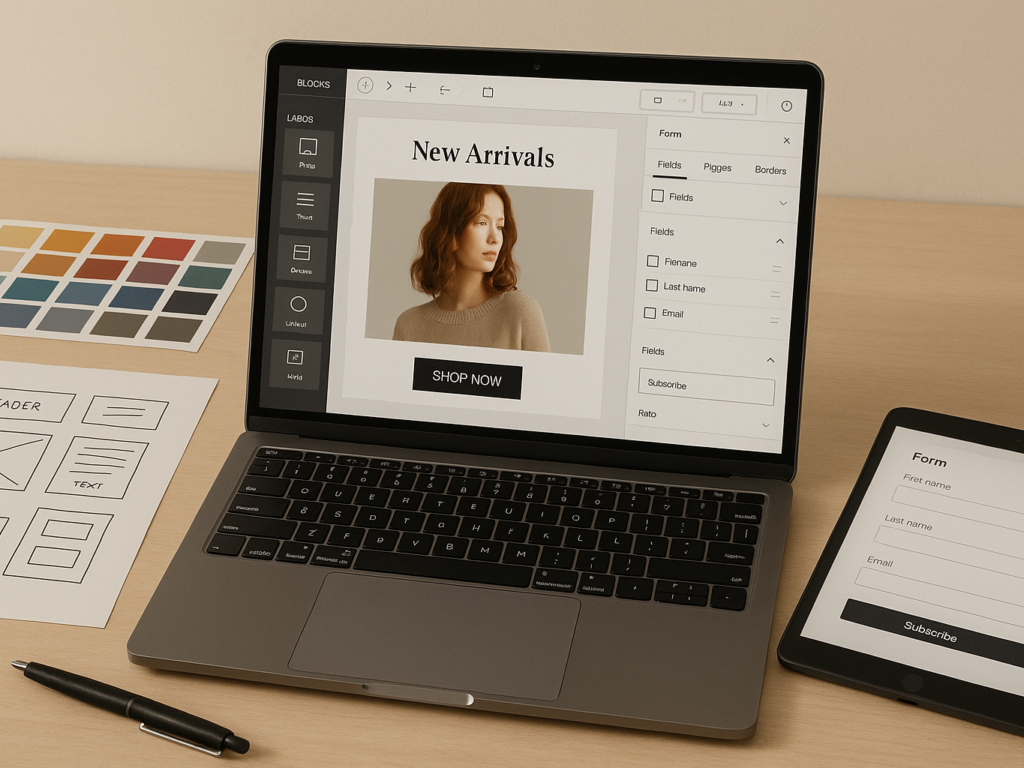
The visual appeal and usability of your marketing emails influence engagement rates and conversions. When examining Klaviyo vs ActiveCampaign, one can see that their design and user experience approaches reveal distinct priorities.
1. Email Templates: 100+ vs 250+ Options
ActiveCampaign leads in template variety with over 250 mobile-friendly, customizable email templates. These designs span multiple categories, including a dedicated “sell a product” collection created explicitly for e-commerce businesses. Moreover, ActiveCampaign offers comprehensive HTML and plain text editing capabilities, along with flexible content blocks.
Klaviyo offers a more modest library of approximately 100-160 pre-built responsive templates. Yet, despite this numerical disadvantage, Klaviyo’s templates are thoughtfully designed for e-commerce scenarios, boasting a strong visual appeal. Both platforms allow for custom template creation, although ActiveCampaign provides more technical options through its HTML editing capabilities.
2. Form Customization and A/B Testing
Interestingly, Klaviyo excels in form design despite having fewer email templates. Its forms come in four styles: embed (inline), popup, full page, and flyout. Many users consider Klaviyo’s form templates “visually stunning” and easily customizable with text and images.
ActiveCampaign also offers four form types (inline, floating box, floating bar, and modal popup). The key difference emerges in testing capabilities. Klaviyo uniquely allows the creation of multiple versions of email forms for split testing, a feature that ActiveCampaign lacks. According to research, more complex forms with additional fields may increase submission rates rather than reduce them.
3. Ease of Use: Minimalist vs Feature-Rich UI
Klaviyo’s interface is primarily described as clean, minimalist, and streamlined. It utilizes dropdown menus for feature-specific settings instead of secondary sidebars, resulting in a more straightforward navigation experience. This simplified approach is particularly beneficial for newcomers to email marketing platforms.
- Uses dropdown-based navigation instead of cluttered sidebars.
- Provides quick access to pre-built e-commerce automation templates.
- Allows easy editing of product-based dynamic content blocks.
ActiveCampaign offers a more feature-rich interface, featuring a left sidebar for primary navigation and secondary sidebars for specific settings. While this design accommodates its broader feature set, it creates a steeper learning curve for beginners. Essentially, ActiveCampaign’s email editor offers advanced capabilities, such as saving custom blocks for future use, but at the cost of initial simplicity.
Both platforms ultimately deliver intense user experiences, with Klaviyo optimized for simplicity and ActiveCampaign designed for power users who need extensive customization options.
Analytics and Reporting Depth
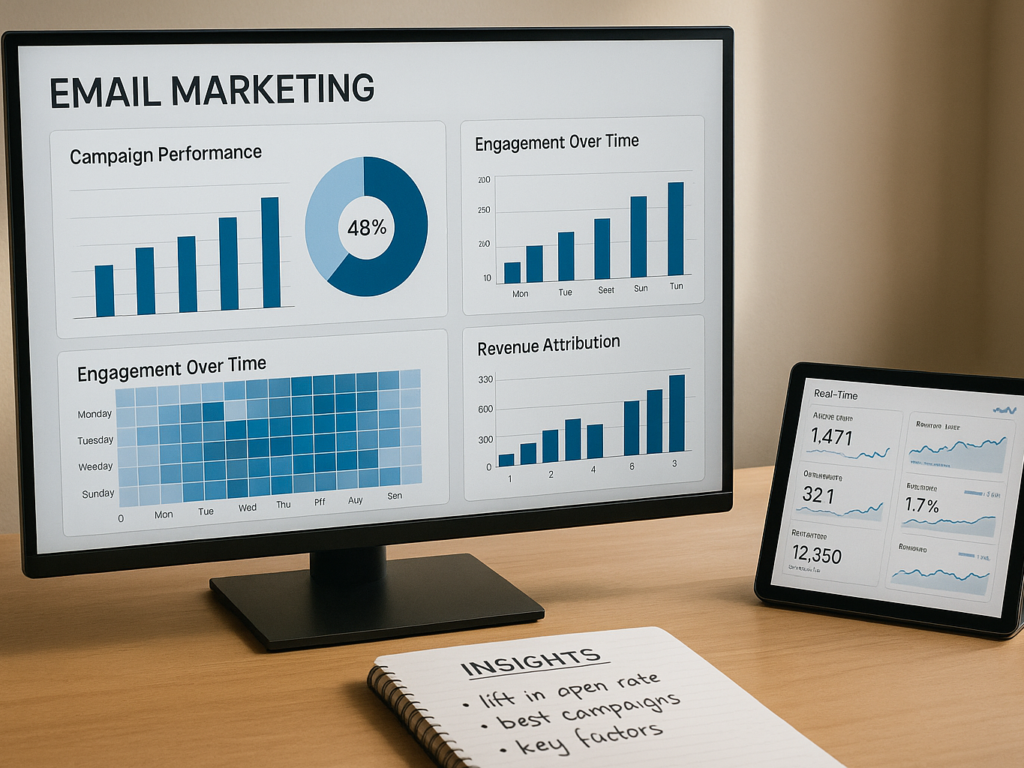
Sophisticated analytics capabilities enable data-driven decisions that optimize marketing performance. Both Klaviyo and ActiveCampaign offer distinct approaches to measuring campaign effectiveness, each with unique strengths.
1. Revenue per Recipient vs Multi-Touch Attribution
Klaviyo emphasizes its Revenue per Recipient (RPR) metric, which measures the revenue generated by each message by dividing total revenue by the total number of messages sent.
The average RPR for Klaviyo email campaigns is $0.11, while SMS messages average $0.12. This straightforward calculation helps identify which campaigns deliver the highest return on investment.
Conversely, ActiveCampaign focuses on multi-touch attribution, tracking how customers interact across multiple marketing touchpoints leading up to conversion. This approach distributes credit across different channels, providing insight into how various elements work together throughout the customer journey.
Therefore, businesses with complex sales cycles often find ActiveCampaign’s reporting more comprehensive for understanding the complete customer journey, or path to purchase.
2. Click Maps and Apple Privacy Toggle
ActiveCampaign’s click map tracking is a distinctive feature not commonly found in email platforms. This visual representation shows precisely which links in your emails attract the most attention, revealing whether readers engage more with links at the top or after scrolling through the content.
Furthermore, ActiveCampaign includes an Apple Privacy toggle that filters out automatic opens from Apple devices running iOS 15 or later. Since these devices automatically “open” emails regardless of human interaction, this feature ensures your metrics reflect genuine engagement rather than inflated numbers. Consequently, marketers receive cleaner data for decision-making, albeit from a smaller sample size.
3. Custom Dashboards and Real-Time Metrics
Both platforms offer customizable dashboards, though ActiveCampaign provides more extensive options. ActiveCampaign’s reporting includes comprehensive metrics for campaigns, automation, contacts, CRM, and e-commerce performance.
These dashboards consolidate information from multiple channels, revealing patterns that might remain invisible when examining each Channel separately.
Klaviyo’s reporting, primarily designed for e-commerce, tracks basic metrics like opens and clicks alongside store revenue earned per recipient. Indeed, its analytics prioritize conversion rates and ROI metrics that matter most to online retailers.
For businesses seeking deeper insights, ActiveCampaign enables the creation of custom reports tailored to specific needs. In contrast, Klaviyo offers benchmark data to compare your performance against industry standards.
Pricing and Integration Ecosystem
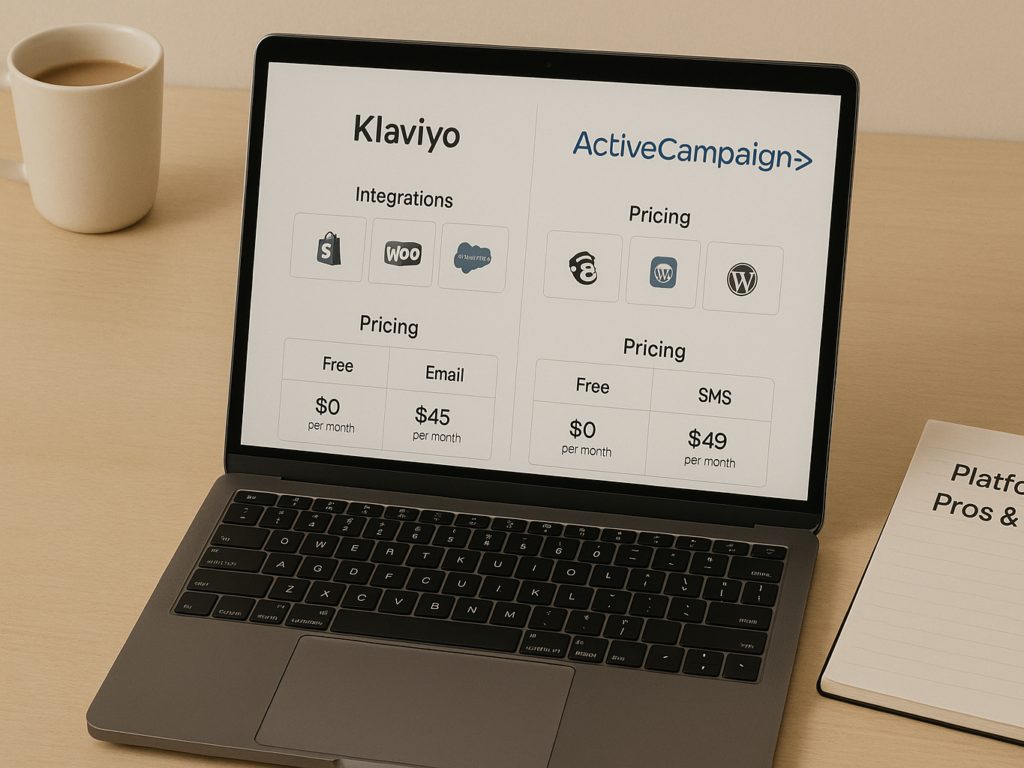
Budget considerations often play a decisive role when selecting between email marketing platforms. Klaviyo and ActiveCampaign offer distinct pricing structures that reflect their target markets and feature sets.
1. Klaviyo Monthly Cost vs. ActiveCampaign Price Tiers
Klaviyo structures its pricing primarily based on contact count, with two main plans: Email-only and Email+SMS. For 1,000 contacts, Klaviyo’s Email plan starts at $30 per month, while the Email+SMS plan begins at $45 per month. As your subscriber base grows, costs increase accordingly, reaching $150 per month for 10,000 contacts on the Email plan.
ActiveCampaign employs a tiered approach with four distinct plans: Starter, Plus, Pro, and Enterprise. Their entry-level Starter plan starts at just $15 per month for 1,000 contacts, making it initially more affordable than Klaviyo. However, prices increase with both the number of contacts and the plan level. The Plus plan costs $49 per month, the Pro plan $79 per month, and the Enterprise plan $145 per month for 1,000 contacts.
Want a deeper dive into ActiveCampaign’s value proposition? Our comprehensive [ActiveCampaign Review 2025: Is Its Pricing Justified? An Honest Review & Alternative Look] determines whether its pricing is justified and explores cost-effective alternatives that might better fit your budget.
2. Free Plan vs 14-Day Trial
One significant difference between these platforms is their approach to free access. Klaviyo offers a genuinely free plan allowing up to 250 contacts and 500 monthly emails, which is ideal for businesses starting their email marketing journey. This plan includes 150 free monthly SMS/MMS credits and email support for the first 60 days.
In contrast, ActiveCampaign doesn’t provide a free plan but offers a 14-day free trial to access all features. This difference may influence your decision, particularly if budget constraints are initially tight.
3. Integration Count: 300+ vs 900+ Apps
ActiveCampaign dominates in terms of integration breadth, offering over 950 app connections compared to Klaviyo’s more modest 350+ integrations. This numerical advantage gives ActiveCampaign users access to a broader ecosystem of tools and platforms.
Nevertheless, both platforms connect with Zapier, extending their integration capabilities to thousands of additional applications. This workaround is particularly beneficial for Klaviyo users who require connections beyond the platform’s native integrations.
4. E-commerce Platform Support: Shopify, WooCommerce, Magento
Both platforms excel at supporting major e-commerce platforms, including Shopify, WooCommerce, and Magento. Klaviyo is often praised for its “deep eCommerce integrations” and “quick setup” with these platforms. Meanwhile, ActiveCampaign has recently enhanced its offerings by including native integrations with WooCommerce, Shopify, BigCommerce, and Magento, even on its Starter plan.
Ultimately, the choice between Klaviyo and ActiveCampaign may depend on your business needs, budget constraints, and existing tech stack rather than integration capabilities alone.
Conclusion: Choosing Between Klaviyo and ActiveCampaign
After thoroughly reviewing both platforms, the choice between Klaviyo and ActiveCampaign depends on your business model and marketing goals. ActiveCampaign offers versatile automation, advanced segmentation, and a lower starting price. It’s ideal for businesses needing complex workflows and multi-channel campaigns, although it has a steeper learning curve.
While Klaviyo is more limited in overall flexibility, it shines for eCommerce. Its user-friendly interface, eCommerce-focused templates, and powerful revenue tracking make it perfect for online retailers. Klaviyo’s free plan, which supports up to 250 contacts, is an excellent way for new e-commerce ventures to build profitable email marketing campaigns.
Ultimately, ActiveCampaign suits businesses wanting comprehensive features and advanced automation. Meanwhile, Klaviyo is better for eCommerce brands focused on revenue-driven marketing. Both platforms can significantly enhance sales when properly used. Choose based on your technical skills, business model, and the complexity of marketing strategies you plan to implement.
FAQs on klaviyo vs activecampaign
Q1. What are the primary differences between Klaviyo and ActiveCampaign?
Klaviyo focuses on e-commerce features, such as abandoned cart recovery and personalized recommendations. ActiveCampaign offers a broader range of tools, including CRM, advanced automation, and over 900 integrations, making it a more suitable choice for businesses that require comprehensive marketing solutions.
Q2. Which platform offers more pre-built templates for automation?
ActiveCampaign provides an extensive library of “automation recipes” covering various industries. Klaviyo offers a smaller, eCommerce-focused selection of “flows” tailored for online stores, emphasizing simplicity and effectiveness for product-based marketing campaigns.
Q3. How do Klaviyo and ActiveCampaign differ in their trigger capabilities?
ActiveCampaign supports multiple triggers per automation, allowing contacts to enter workflows through different pathways. Klaviyo limits flows to a single trigger, simplifying setup but reducing flexibility for complex or multi-channel automation strategies.
Q4. Which platform is more suitable for businesses with complex marketing needs?
ActiveCampaign is ideal for businesses that require advanced segmentation, multi-entry workflows, and broad integration capabilities. Klaviyo excels for eCommerce brands focused on revenue-driven, easy-to-implement automation to enhance customer experience and boost online sales.
